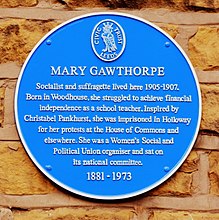Bramley, Leeds
[4] At the time of the Domesday survey, the nucleus of the settlement was probably located at Stocks Hill, and it developed in a linear fashion along today's Town Street.This historic pump and trough are the last reminders of Bramley Village Green which was surrounded by medieval cottages and yards.[11] Mary Gawthorpe described her experience living and working at Hough Lane School in Bramley between 1905 and 1907 in her autobiography.She recalls: 'Bramley was an oasis of peace, and old established centre of homes and living yet within the city bounds... from our kitchen at Warrel's Mount we looked out on open fields.[12] Much of Bramley was redeveloped in the 1960s and 1970s, albeit in an unsympathetic manner that damaged the historic integrity of the area and altered the appearance and the character of the town significantly.[13] From 2008, following a time of deterioration of the shopping centre, new anchor stores such as Farmfoods and Tesco took over existing premises or occupied new ones in the course of a general refit.[16] The four Georgian style houses built c. 1803 to the right-hand side of the baths were the original homes of the iron foundry owner and his three children.Estates in Bramley which have residents' associations include Moorside[17] and Ganners, Landseer, Rossefield,[citation needed] and Newlay and Whitecote.Bramley RLFC were founded in 1879, their earliest permanent ground was Barley Mow which hosted New Zealand on their tour of Great Britain in 1907.






West YorkshireOS grid referenceLondonMetropolitan boroughCity of LeedsMetropolitan countyRegionYorkshire and the HumberCountryEnglandSovereign statePost townPostcode districtDialling codePoliceAmbulanceYorkshireUK ParliamentLeeds West and Pudseycouncil housingDomesday BookOld Englishwater pumpwater troughblue plaqueantiquarianLeeds City MuseumJohn GottAnglo Saxontownshipchapelrycivil parishMary GawthorpeSeacroftanchor storesFarmfoodsYorkshire Evening PostMember of ParliamentChancellor of the ExchequerRachel ReevesLeeds and Liverpool CanalBramley ParkreservoirfireworksEdwardiangymnasiumRussian steam roomEdwardian eraNewlayBaptistRoman CatholicsJehovah's WitnessesMethodistsAnglicanasset of community valueBramley railway stationLeeds-Bradford LineLeeds stationNew PudseyBramley RLFCBarley MowNorthern UnionMcLaren FieldHeadingleyBramleyBramley BuffaloesNational League ThreeNational Conference LeagueYorkshire Men's LeagueErnie WiseMorecambe and WiseEast ArdsleyGeoffrey AppleyardJamie PeacockListed buildings in Leeds (Bramley and Stanningley Ward)Wayback MachineA Vision of Britain through TimeGENUKICeremonial countyCity of BradfordCity of WakefieldMetropolitan Borough of CalderdaleMetropolitan Borough of KirkleesBaildonBatleyBingleyBirstallBradfordBrighouseCastlefordClaytonCleckheatonDenholmeDewsburyEllandFarsleyFeatherstoneGarforthGomersalGreetlandGuiseleyHalifaxHaworthHebden BridgeHeckmondwikeHemsworthHipperholme and LightcliffeHolmfirthHorburyHorsforthHuddersfieldIlkleyKeighleyKippaxKirkburtonKnottingleyLiversedgeMelthamMirfieldMorleyNormantonOssettPontefractPudseyQueensburyRothwell